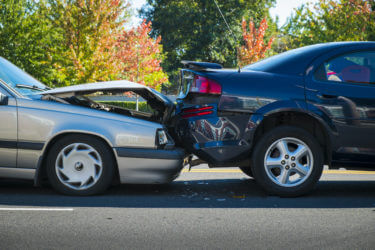
According to the NHTSA, rear-end collisions are the most frequently occurring type of car accident. Of all drivers experiencing a crash in 2000, 36% were involved in rear-end crashes.
After someone unexpectedly rear-ends you, you may feel frightened and unsure how to pay your bills. Understand that you are not alone. A personal injury attorney will listen to your situation and expertly evaluate your claim.
Every accident is different, so looking for the average settlement for a rear-end collision in California isn’t practical. Rest assured, your personal injury attorney will take every step to secure the maximum financial recovery for you. At Saeedian Law Group, our attorneys are dedicated to the rights of injured Californians and will give you the individualized attention and care you deserve.
What Is an Average Settlement for a Rear-End Car Accident?
After a car accident, you should first report the accident to law enforcement. The law requires drivers to report accidents involving injuries to the city police or California Highway Patrol within 24 hours. You must also report the accident to the DMV within 10 days. Then you should seek medical care.
Injuries like whiplash are common in rear-end collisions and often do not appear until days or weeks after a crash. Your health insurance should help with emergency care until the at-fault party is identified.
Next, California law requires the driver who failed to drive with reasonable care to pay for the damages they caused. The police, the insurance companies, or the courts decide each driver’s share of the responsibility. When you file a claim with the at-fault driver’s insurance, they will likely offer you an amount to settle out of court.
Every California auto insurance policy must include liability coverage of up to $15,000 for the death or injury of any one person, a total of $30,000 for the death or injury of more than one person in any one accident, and $5,000 for property damage. If your costs exceed the at-fault driver’s policy limits, you can sue them for additional costs. The insurance company’s settlement offer should compensate you for all the damages caused by the at-fault driver but will not often exceed the policy limits.
What Should the Average Settlement for a Rear-End Collision Cover?
Before accepting any insurance settlement, you should consider what damages you can recover if you file a lawsuit against the at-fault driver. The law allows you to receive compensation for the economic and non-economic damages you sustained in the accident. Economic damages typically include compensation for:
- Past and future medical expenses;
- Lost earnings (if you take time off work because of your injuries);
- Lost earning capacity (if you cannot work at the same capacity as before the accident);
- Loss of ability to provide household services;
- Damage to personal property (costs for vehicle repairs);
- Loss or destruction of personal property; and
- Loss of use of personal property (when your vehicle is being repaired).
The compensation for damage to your vehicle can be either the amount necessary to repair the vehicle or the vehicle’s actual cash value (ACV), depending on the policy. You may also experience other losses that are not as easy to quantify, called non-economic damages. Non-economic damages should compensate you for any:
- Past and future physical pain,
- Mental suffering,
- Loss of enjoyment of life,
- Disfigurement,
- Physical impairment,
- Inconvenience,
- Grief,
- Anxiety,
- Humiliation, and
- Emotional distress.
If the settlement offer does not fairly compensate you for these damages, you should not accept it. Instead, you should contact an attorney with experience to negotiate with the insurance companies. You are entitled to a fair settlement.
What If I’m Partially at Fault for an Accident?
Any driver that fails to drive with reasonable care can be at fault for an accident. California law follows pure comparative fault when it comes to responsibility. Pure comparative fault means that you can still recover damages caused by another driver even if you are partially at fault. Your percentage of fault will reduce the amount the other party must pay. For example, consider your damages from the accident are $100,000. If you are 10% at fault and the striking driver is 90% at fault, the striking driver will pay only $90,000 of the damages. Keep in mind that if your insurance company determines that you are 51% or more at fault, your premium may go up when you renew your policy.
How Long Do I Have to Consider a Settlement Offer?
You can decide to take the first settlement offer you receive, but your damages are likely still accruing. If you have filed a lawsuit and the insurance company offers a settlement, the offer will expire within 30 days or on the day of trial. If you have not yet filed a lawsuit, California requires you to file a claim for personal injury within two years of the accident. Once you accept a settlement offer, you cannot change your mind. The insurance company then has 30 days to pay you the agreed-upon amount.
How Can the Saeedian Law Group Help After an Accident?
The true value of your damages is likely more than the average settlement for a rear-end collision in California. Only an experienced attorney can advise you on the value of your claim. Nonetheless, you have the right to recover fully for the damages you sustain in an accident. At Saeedian Law Group, we refuse to sell any case short. We recognize that every client’s case is unique and deserves individual attention and care. Our record shows millions of dollars in verdicts & settlements recovered for our clients, including convincing insurance to pay policy limits. Call us for a free consultation today, and let us negotiate with the insurance company while you focus on healing.